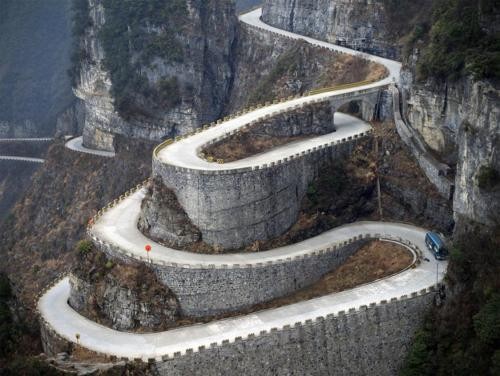TRAVEL ALTERNATIVES

Travel Alternatives
Electric Vehicles Global Warming Car Pollution Mass Transit Envirotopics Green Cars Fuel Cells Exercise Bicycle Oil
WHAT CAN YOU DO TO REDUCE :
Let's start instituting a "top five ways to get there" list to go along
with every event being organized or even for existing stores, destination
spots. The list would appear in the order of least impactful to most.
Another idea would be to convince the major map websites (a la MapQuest.com
to include a first question "What mode of
An easy way to get the carpool thing going is www.carpoolconnect.com
Now if we could find a similar website that allows a person to plug in
a longer, more infrequent trip, in case someone else would like to share
the ride, driving and gas.
If you still have to drive a vehicle, then it is important to do it efficiently.
Human Car http://www.humancar.com/news_article_membrana.htm
It is a present
day muscle-car, but not in a figurative sense. If in the world of cars "brawny"
is called "highly-charged" then the technical miracle of this device is a true
athlete in the world of vehicle mobility. It is not the
streamline body that powers this car; it is the force of four people, who work
immediately by way of muscles in the hands and legs. This force accelerates the
car to automobile speeds. A company from
Seattle developed this uncommon transportation device. It is called the
HumanCar, that is to say, "pour on the muscular thrust." We have seen other
inventions that are similar, but the HumanCar adheres to an interesting
principle: the means to which the machine is set in motion. At the basis of
machine is a three dimensional frame from the steel tubes. Four people sit
back-to-back to each other on the mobile seats and hold controls on long levers.
Both seats and controls connect together with thrusts, and they synchronously
rock back and forth, much like the manner of seats and oars in sport kayaks.
Rowing on the
wheels is not a new idea. However, the authors of this machine assume that over
the course of time, this may become conventional. Both seats and
controls are inclined at the sides. Passengers of the HumanCar govern the
turning of the front wheels by leaning. As a result, as the company asserts,
passengers have intuitive control over the machine (like the driver of a
motorcycle does, only in this case, there are four drivers). It is by utilizing
the many muscles of the body that makes it possible to reach high speeds. Even
on a small descent, the HumanCar can reach speed of 100 kilometers an hour.
According to our own experience, we know that speeds of 30-40 on a bicycle
(heading downhill) are frightful. The HumanCar was
created years ago. But recently its authors improved the apparatus, after adding
a small storage battery and electromotor (electrical assist). It is no so much
to ensure the motion of the vehicle, but to reduce the load on each person for a
longer distant trip. For technical
details: http://www.humancar.com/design.htm
"The HumanCar is
an arrangement of mechanical parts that convert oscillatory motion into
rotational motion about one axis. Simultaneously, it converts oscillatory motion
about another axis into oscillatory motion about an axis connected to a
reference frame." Join a Travel Club Have you ever considered owning timeshare as a way of vacationing and staying at beautiful and luxurious resorts throughout the world? Timeshare is a popular way to vacation where you often times have to pay tens of thousands of dollars up front plus hundreds every year for taxes and expensive maintenance for a designated week(s) of your choosing. Look for a resort club membership that entitles you to unlimited access to vacations with accommodations. Find a club that does not have expensive annual dues, maintenance fees and exchanges fees when you want to change what location you want to vacation at. Travel Exchanges Travel lightly and for free with one of the many on-line travel exchanges, such as airbnb.com, wooffing, home exchanges, couch hostiles, and eco-tours. 10 Tips to Get Off Oil 1. Keep up on your vehicle maintenance. On average, an
efficient engine could cut your gasoline use by over 46 gallons per year, saving
you $139 and reducing your carbon footprint by 900 kilograms per year.
2. Keep your tires inflated and invest in low-rolling resistance tires. With well-inflated advanced tires, you’ll save $50 every year on gasoline. 3. Drive efficiently. Driving at a steady, reasonable pace can reduce your fuel use by as much as 15 percent. That means over $175 per year in savings on gasoline, and over a ton of carbon removed from the atmosphere per person. 4. Get rid of unnecessary weight in your car. Your fuel efficiency drops by 1 percent for every 100 pounds of stuff that you keep in your car, so it pays to clean out your trunk. 5. Carpool. Social networking websites like eRideShare have made it increasingly easy and convenient to match up with people with similar commutes. And companies such as NuRide offer discounts at restaurants, free tickets to events, and other rewards to commuters who carpool, vanpool or find other green ways to commute to work. [1] 6. Consider telecommuting as an alternative to the daily drive to work. New technologies are making it easier and easier to do more of your work from home. Working from home saves Americans an average of 46 minutes a day on their commute, which adds up to over 100 hours a year that would otherwise be wasted in traffic—more than the total vacation time many of us earn in a year. 7. Be efficient with your shopping and other travel. When you can walk, walk. When you have to drive, plan ahead and try to hit multiple stores in one trip. Shopping locally saves the gasoline consumed by trucks and ships transporting goods, and shopping online saves the gasoline costs of driving to the store. 8. When you purchase a car, consider its energy costs and impact on the environment. This summer alone, a 60 mpg car would save the average consumer over $500 at the pump. Plug-in electric vehicles, meanwhile, offer superior driving performance and can be operated for just pennies per mile while producing no tailpipe emissions. 9. Prioritize public transportation and walkable, mixed-use communities when you choose a home. Online resources such as the Housing and Transportation Affordability Index can help you figure out which neighborhoods have the most transportation choices. [2] 10. Tell your political leaders that you want real transportation alternatives to get us off oil. The first step is for President Obama to set fuel efficiency standards for passenger vehicles at 60 mpg by 2025. The second step is for Congress and state leaders to pass legislation that will provide more transportation alternatives, and invest in electric vehicles. Follow our campaign at our Twitter and Facebook pages and help get this country off oil.
Take a look at all the unsold cars:
HyperloopReturn to HOME page . . . RELATED TOPICS: | |

